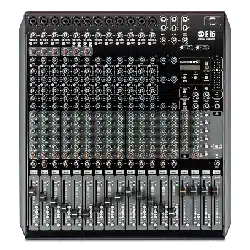Loading ...
Loading ...
Loading ...

7
ENGLISH
[10] Z.CORE DSP FX PANEL
The Z.CORE DSP FX is the effects unit present inside the RCF E Series mixers, featuring a high-quality 32-bit floating-point DSP engine, running at a
sample rate of 48 kHz.
Z.CORE DSP FX include 80 different ROM effects programs divided as follow:
P001-P040: REVERBS including: HALL, ROOM, PLATE, AMBIENCE algorithms (up to 11 s decay time)
P041-P060: DELAYS including: STEREO, VINTAGE, MODERN, ER, DUAL algorithms (up to 1 s delay)
P061-P080: MODULATION EFFECTS including: CHORUS, FLANGER, TREMOLO algorithms
The memory locations included between:
U01-U20 (USER1 to USER20) are available for storing user edited programs, becoming ready for a quick recall.
To navigate the Z.CORE DSP FX unit a two-line display is present: the upper line shows the Preset Name, while the lower line indicates the Preset
Number and algorithm type.
To select a program or user memory, rotate the encoder (orange) called PRESET/VALUE; then, press the encoder to recall the selected program.
Three buttons are present below the display:
- PARAM1 / HOLD FOR USER RECALL
- PARAM2
- TAP / HOLD TO SAVE
Pressing the PARAM1 button enables the edit of the first parameter:
- DECAY when Reverb Algorithms are in use
- TIME when Delay Algorithms are in use
- RATE when Modulation Algorithms (chorus, flanger, tremolo) are in use.
Rotate the encoder to change this value.
Pressing the PARAM2 button enables the edit of the second parameter:
- DAMPING when Reverb Algorithms are in use
- FEEDBACK when Delay Algorithms are in use
- DEPTH when Modulation Algorithms (chorus, flanger, tremolo) are in use.
Again, rotate the encoder to change this value.
By holding down the PARAM1 button for more than 3 seconds (HOLD FOR USER RECALL) it’s possible to have direct access to the USER Library (U01
U20). Rotate the PRESET/VALUE encoder to navigate and press it to confirm the selection, and quickly recall a previously saved USER Preset.
The button TAP/HOLD TO SAVE has a double function. When the current effect is a Delay, the button synchronizes the delay time to the current music.
Holding down this button it’s possible to save the current effect program to one of the 20 USER PRESETS.
Hold down the TAP/HOLD TO SAVE button for more than 3 seconds, and on the display will appear the question: Save to USER1? Rotating the ENCODER
change the number of USER from 1 to 20; select an available USER preset and press the encoder to confirm. Now on the display the default name of the
chosen USER preset will appear. The display shows: ENTER NAME to be written. Rotate the ENCODER to select the preferred letter, number or symbol.
You can move the cursor left or right using the PARAM1 and PARAM2 buttons, and when the name of your USER preset is complete, press the encoder
to confirm. The stored preset will appear on the display.
The preset currently in use, either USER or ROM, will be recalled automatically at power-up.
When the effect send is muted via footswitch (see sect. 38 of rear panel description) the red LED close to the TAP/HOLD TO SAVE button turns on, and
the display shows the message “FX MUTE“ indicating the FX is muted externally.
In this condition, the effect can be unmuted by pressing the TAP/HOLD TO SAVE button once. When the effect is unmuted, the red LED and the button
return to their normal function.
[11] LEVEL METER
This 12 LED elements level meter normally allows you to control the Main Mix output level. When a channel PFL button is
pressed, the level meter shows the PFL level present in the selected channel. Keep the input level below the “0” indication to
avoid overloaded signals that can cause distortion.
[12] USB OUT – USB IN BUTTONS
These two buttons determine where the USB audio paths are routed to/from. USB OUT – select which stereo audio channels
are destined to a computer for recording: when the button is in up position the audio signals present in MAIN MIX are assigned
to the USB port of a computer; when the button is in down position (pressed) BUSSES 1/2 audio channels are routed to the
USB port.
USB IN determines where to route the stereo audio channels played from an external computer connected to the USB port:
when the button is in upper position (not pressed) the audio is routed to 2TRACK IN audio path and its level is controlled by the
2TRACK/USB Grey Knob (see section 13): If the USB IN button is pressed the audio coming from an external computer is routed
to the stereo channel 15/16; in this case the USB audio substitutes the analog audio input (see section 3) and takes advantage
of all the features provided by the stereo channel such as EQs, AUX sends, BAL and fader control.
FRONT PANEL / PANNELLO FRONTALE
Loading ...
Loading ...
Loading ...
